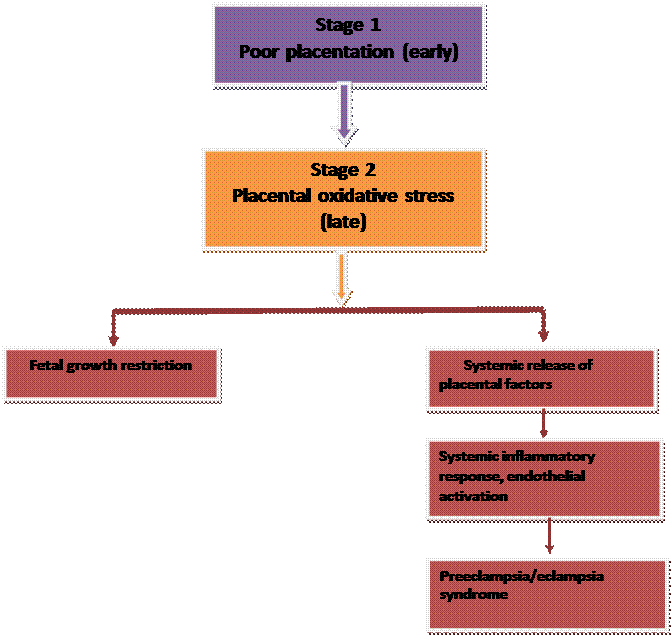 |
Pathophysiology of HP. Pathogenesis of Preeclampsia as a Two-Stage Disorder. Complications of HP. Symptoms, diagnosis and management of HP
|
|
|
|
Pathophysiology of HP
The pathogenesis of preeclampsia is complex; numerous genetic, immunologic, and environmental factors interact. It has been suggested that preeclampsia is a two-stage disease (figure…. pathogenesis…. ). The first stage is asymptomatic, characterized by abnormal placental development during the first trimester resulting in placental insufficiency and the release of excessive amounts of placental materials into the maternal circulation. This in turn leads to the second, symptomatic stage, wherein the pregnant woman develops characteristic hypertension, renal impairment, and proteinuria and is at risk for the HELLP syndrome (hemolysis, elevated liver function enzymes and low platelets), eclampsia, and other end-organ damage. The pathogenesis of hypertensive syndromes caused by gestation can be represented as follows (Fig. 166).
Pathogenesis of Preeclampsia as a Two-Stage Disorder

Fig. 166. Pathogenesis of preeclampsia
Complications of HP
Fetal growth restriction or death may result. Diffuse or multifocal vasospasm can result in maternal ischemia, eventually damaging multiple organs, particularly the brain, kidneys, and liver. Factors that may contribute to vasospasm include decreased prostacyclin (an endothelium-derived vasodilator), increased endothelin (an endothelium-derived vasoconstrictor), and increased soluble Flt-1 (a circulating receptor for vascular endothelial growth factor). Women who have preeclampsia are at risk of abruptio placentae in the current and in future pregnancies, possibly because both disorders are related to uteroplacental insufficiency.
The coagulation system is activated, possibly secondary to endothelial cell dysfunction, leading to platelet activation. Hemoglobin levels greater than 13 g/dL suggest the presence of hemoconcentration. Low levels may be due to microangiopathic hemolysis or iron deficiency. Prothrombin time (PT) and/or international normalized ratio (INR) and/or activated partial prothrombin time (aPTT) results may be abnormal in consumptive coagulopathy and disseminated intravascular coagulopathy (DIC) complicating severe preeclampsia. The HELLP syndrome (hemolysis, elevated liver function tests, and low platelet count) develops in 10 to 20% of women with severe preeclampsia or eclampsia; this incidence is about 100 times that for all pregnancies (1 to 2/1000). Most pregnant women with this syndrome have hypertension and proteinuria, but some have neither.
Maternal deaths can occur among severe cases, but the progression from mild to severe can be rapid, unexpected, and occasionally fulminant.
Symptoms, diagnosis and management of HP
Pregnancy hypertensions may be asymptomatic or may cause edema or excessive weight gain. Facial or hand swelling (the patient’s ring may no longer fit her finger), is specific symptom. A woman's feet might swell too, but swollen feet are common during pregnancy and may not signal a problem. Patient may have petechiae, which is a sign of coagulopathy. Clinical findings: elevated blood pressure, too much protein in the urine, increased reflex reactivity, indicating neuromuscular irritability, which can progress to seizures (eclampsia). The patient has high blood pressure, too much protein in the urine, increased reflex reactivity, which indicates neuromuscular excitability, which can progress to seizures (eclampsia).
|
|
|
Assessment and Diagnosis
When taking blood pressure, the woman should be rested and sitting at a 45-degree angle. The blood pressure cuff should be of the appropriate size and should be placed at the level of the heart. Multiple readings should be used to confirm the diagnosis. Korotkoff phase 5 is the appropriate measurement of diastolic blood pressure. The method used should be consistent and documented. Automated blood pressure methods need to be used with caution, as they may give inaccurate blood pressure readings in pre-eclampsia. All women who present with new-onset hypertension should have the following tests:
— CBC
— Serum alanine aminotransferase (ALT) and aspartate aminotransferase (AST) levels
— Serum creatinine
— Uric acid
— 24-hour urine collection for protein and creatinine (criterion standard) or urine dipstick analysis
— Coagulation profile (prothrombin time [PT], activated partial thromboplastin time [aPTT], and fibrinogen) should also be evaluated. (But its clinical value is unclear when the platelet count is 100, 000/mm3 or more with no evidence of bleeding).
Other procedures: Transabdominal US, to assess the status of the fetus and evaluate for growth restriction; umbilical artery Doppler ultrasonography, to assess blood flow; Cardiotocography; Byophysical Profile. Head CT scanning may be used to detect intracranial hemorrhage in patients with sudden severe headaches, focal neurologic deficits, seizures with a prolonged postictal state (ictus epilepticus), atypical presentation for eclampsia.
Additional studies required for suspected HELLP syndrome:
• Peripheral blood smear
• Serum lactate dehydrogenase (LDH) level
• Indirect bilirubin
|
|
|


